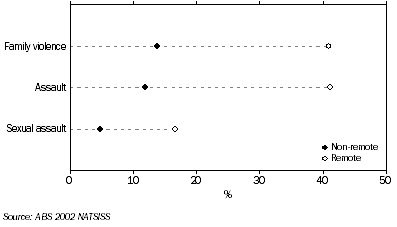EXPOSURE TO VIOLENCE
Aboriginal and Torres Strait Islander people are much more likely than non-Indigenous people to be victims of violence and to be hospitalised for injuries arising from assault (AHMAC 2006). Victims of violence may suffer serious injury, disability or death and, together with those who witness violence, are more likely to experience debilitating stress and trauma (ABS & AIHW 2005). Similarly, people who perceive their neighbourhood as unsafe may feel isolated and be discouraged from accessing local services and recreational facilities, or from creating social networks close to their homes.
In the 2002 NATSISS, nearly one-quarter (24%) of Indigenous people aged 15 years or over reported being a victim of physical or threatened violence in the previous 12 months; nearly double the rate reported in 1994 (13%). Rates of victimisation were similar for people living in remote and non-remote areas (23% compared with 25%) and for men and women overall (26% compared with 23%). Younger people were more likely to have been a victim of physical or threatened violence in 2002, with men aged 15-24 years having the highest rate of any age group (36%). When age differences between the Indigenous and non-Indigenous populations were taken into account, Indigenous people aged 18 years or over experienced double the victimisation rate of non-Indigenous people in 2002. For more information on victimisation, see Chapter 8 in the 2005 edition of this report.
The 2002 NATSISS also collected information on an individual's experience of violence within their neighbourhood or community. Indigenous people in remote areas were three times as likely as those in non-remote areas to report family violence (41% compared with 14%), assault (41% compared with 12%) or sexual assault (17% compared with 5%) as a neighbourhood/community problem (graph 8.11). They were also more likely to report witnessing violence (30% compared with 10%) and abuse or violent crime (17% compared with 9%) as life stressors experienced in the last 12 months.
8.11 SELECTED NEIGHBOURHOOD/COMMUNITY PROBLEMS, Indigenous persons aged 15 years and over
- 2002

 Print Page
Print Page
 Print All
Print All
 Print Page
Print Page
 Print All
Print All